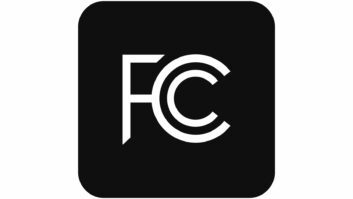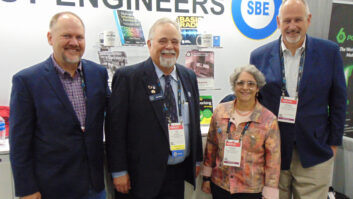You might think this is a photo of Clara, Lu and Em, the radio stars named on the side of the engine.
Actually, it shows three of my four aunts, Louise (Muggs to us), 19, in the car, Lorraine (Bobbie), 21, seated on the running board and Josephine (Jo), 23, standing — flappers all. I date the picture to spring of 1931.
The girls had nothing to do with the radio show “Clara, Lu ’n Em” but they were always getting into something, and likely marked the car up themselves. The family lived in southwest Michigan and would have listened to Chicago radio stations.
(click thumbnail)
I found the photo in a family album and it prompted me to do some digging. For me, this image demonstrates the impact radio had by the early 1930s and how it was beginning to rate with movies for star status.
“Clara, Lu ’n Em” is considered to be the first radio soap opera. It started on WGN on June 16, 1930, and moved to NBC Blue (KYW) on Jan. 27, 1931, which is how I estimate the photo’s date. Westinghouse moved KYW from Chicago to Philadelphia in 1934.
The program aired evenings until Feb. 15, 1932, when it moved to 10:15 a.m. — and set the precedent of daytime serials for women sponsored by soap companies.
Colgate-Palmolive Super Suds, a dishwashing soap, was the sponsor when it moved to daytime on NBC Blue; some references say Colgate-Palmolive sponsored it even earlier. Chipso Flakes (see the car’s roof) was a Procter and Gamble product for washing clothes in machines. It may have been a sponsor prior to 1932, though I find no references to that.
Procter and Gamble became the biggest sponsor of soap operas, but Colgate-Palmolive is thought to be the first. Prior to “Clara, Lu ’n Em” moving to the daytime slot, cooking and household hints programs dominated the limited daytime schedule on network radio, according to the website Old-Time Radio.
“Clara, Lu ’n Em” also is thought to be the first show to run a contest. You could send in two Super Suds 10 cent box tops, or one 20 cent top, and hope to win a new Packard automobile worth $1,000. The Encyclopedia of Old-Time Radio dates the first premium to 1933, when you could mail in a box top and receive a spoon from the 1933 Chicago World’s Fair. “Clara, Lu ’n Em” World’s Fair spoons are available on eBay today.
“Clara, Lu ’n Em” was developed in 1925 as a skit by sorority sisters at Northwestern, Louise Starkey, Isobel Carothers and Helen King. When the three couldn’t find jobs during the Depression they took the skit to WGN in 1930.
The show came to an end in 1936 when Isobel Carothers died from pneumonia at the age of 32. The others decided not to continue, though they revived it on CBS in 1942 with another former sorority sister, Harriet Allyn. It didn’t last long. Allyn went with the show into syndication with another Chicago radio personality, Fran Allison, but the 1945 effort didn’t thrive either.
A sad note is that within a few months of Isobel Carothers’ death, her brother Wallace Carothers committed suicide by drinking a concoction of lemon juice and potassium cyanide. Wallace was a chemist for Dupont who had developed neoprene in 1930 and nylon in 1934. What else might he have come up with we’ll never know.
You can hear audio of “Clara, Lu ’n Em” at archive.org/details/ClaraLuEm.
Information for this article came from “On the Air: The Encyclopedia of Old-Time Radio” by John Dunning, Oxford University Press, 1998, and the websites nndb.com, www.old-time.com and Wikipedia.
The author is director of engineering and operations for WAMU(FM) at American University in Washington.













